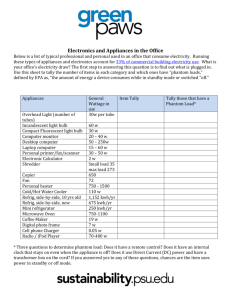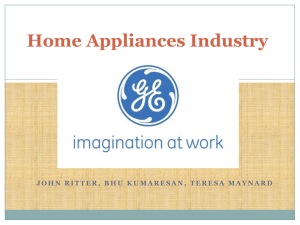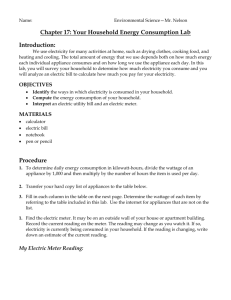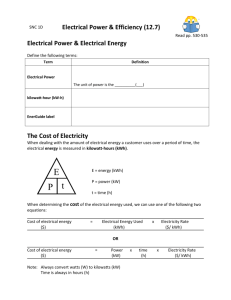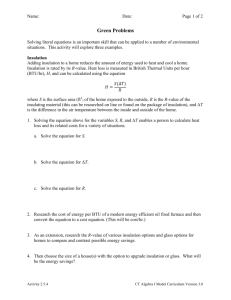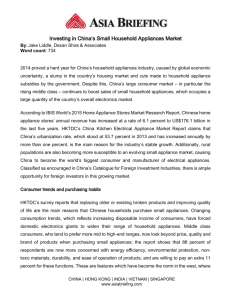Lesson Plan Relevance To Externship
advertisement
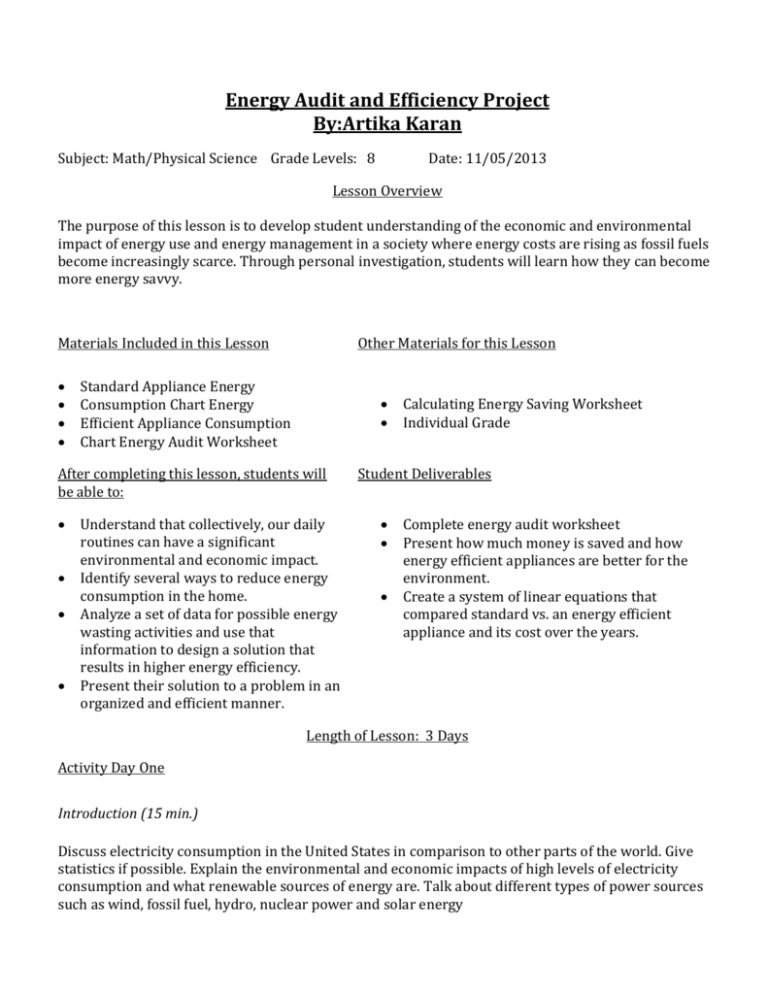
Energy Audit and Efficiency Project By:Artika Karan Subject: Math/Physical Science Grade Levels: 8 Date: 11/05/2013 Lesson Overview The purpose of this lesson is to develop student understanding of the economic and environmental impact of energy use and energy management in a society where energy costs are rising as fossil fuels become increasingly scarce. Through personal investigation, students will learn how they can become more energy savvy. Materials Included in this Lesson Other Materials for this Lesson Standard Appliance Energy Consumption Chart Energy Efficient Appliance Consumption Chart Energy Audit Worksheet After completing this lesson, students will be able to: Understand that collectively, our daily routines can have a significant environmental and economic impact. Identify several ways to reduce energy consumption in the home. Analyze a set of data for possible energy wasting activities and use that information to design a solution that results in higher energy efficiency. Present their solution to a problem in an organized and efficient manner. Calculating Energy Saving Worksheet Individual Grade Student Deliverables Complete energy audit worksheet Present how much money is saved and how energy efficient appliances are better for the environment. Create a system of linear equations that compared standard vs. an energy efficient appliance and its cost over the years. Length of Lesson: 3 Days Activity Day One Introduction (15 min.) Discuss electricity consumption in the United States in comparison to other parts of the world. Give statistics if possible. Explain the environmental and economic impacts of high levels of electricity consumption and what renewable sources of energy are. Talk about different types of power sources such as wind, fossil fuel, hydro, nuclear power and solar energy 2 Preparatory Activities & Prerequisite Knowledge: Basic algebra skills are required to perform some calculations, though simple addition composes the majority of the exercises. Vocabulary: Energy Energy end user Kilowatt hour Energy provider Efficiency Voltage Wattage Amperage Students should have completed a unit on energy and energy sources in which they have gained a general understanding of where electricity comes from and how electricity helps us to do work. Student understanding of renewable energy technologies is suggested and students should be already familiar with: Electricity Electric Current Hydro/Nuclear Power Fossil Fuels Wattage Renewable Energy General Algebraic Activity Day Two Introduce Energy Audit Assignment (15 min.) Discuss the capability to reduce energy consumption through energy efficient technologies and practices. Review Standard Appliance Energy Consumption (Data Sheet 1) and Energy Efficient Appliance (data sheet 2) data sheets for use in energy audit Explain to students that the techniques and data used in this exercise are simplified for student use. Professional energy audits are very precise and more complex. Explain rules for calculating energy usage in the school. Discuss proper behavior while auditing the school. (Other teachers may not appreciate loud students in the hallways) Guided Energy Audit of the School (30 min.) Accompany students throughout the school as they record type and number of light-fixtures and appliances. Refer to the Standard Appliance Energy Consumption data sheet for appliances that can be used in this exercise. 3 Draw attention to the appliance information tags that can be found either on the back or bottom of most appliances. These tags generally contain voltage and amperage as well as additional information supplied by the manufacturer. Use any available opportunity to point out energy efficient or wasteful practices. Compile Energy Audit of the School (20 min.) Instruct and lead students in calculating energy consumption and energy savings for the school using data sheet 2. Discuss results. Activity Day Three Introduce Home Energy Classwork (40 min.) Explain that the same principles apply to the home energy audit as the school energy audit, but likely more energy efficient technologies are available for home appliances than in the school. Give students worksheets for home energy audit and assign the audit as homework. They can choose 5-10 appliances from the standard appliances and energy star appliances and calculate how many watts was saved and the how much money is saved each month and yearly. Review Calculating Energy Savings ( Use Data set 2A) worksheet. Remind students to take note of the appliance information tags that are easily accessible to them as they perform their energy audit. Create a system of linear equations for regular and energy efficient fluorescent light bulbs, include a t-chart and graph the system on a rule of four poster. NOTE: Be sure to remind students to be extremely careful when handling electrical appliances. Disconnect appliances from power source if possible. Suggest that students try to discover ways to conserve electricity at home. Familiarize students with the grading rubric. 4 Enrichment Suggestions After doing the in class energy efficiency worksheet, students can do an energy audit of their own home to see how much power they are conserving or not. They can also present what ways they can conserve energy and how much money they are spending on non energy efficient bulbs or appliances. Student Resources SMUD- www.smud.org is an excellent site to learn about conservation of energy and do an energy audit of your own home. SMUD’s website also provides students with ways to be more energy efficient including some actions that don’t require a huge amount of money from the homeowner’s part. (for example: turning the AC temperature to 78 degrees in the summer months) Common Core Academic Standards 11-12.9. Draw evidence from informational texts to support analysis, reflection, and research. (A8.0) Algebra A SSE: 1) Interpret expressions that represent a quantity in terms of its context. a. Interpret parts of an expression, such as terms, factors, and coefficients. b. Interpret complicated expressions by viewing one or more of their parts as a single entity. For example, interpret P(1+r)' as the product of P and a factor not depending on P. (A8.0, A10.0) Graph a linear equation as well as a system of linear equations. Statistics and Probability: 6) Evaluate reports based on data (A2.0, A8.0) CTE Pathway Standards A8.0 Implement processes to support energy efficiency. A8.1 Understand the relationship between power and energy efficiency. A8.2 Outline how domestic and industrial appliances and systems affect the environment, such as water units and heating and cooling systems. A8.3 Compare costs of alternate/renewable energy sources, systems, and appliances and traditional energy sources, systems, and appliances. A8.4 Conduct an energy audit. Lesson Plan Relevance To Externship Students will learn about the different types of renewable energy sources which is exactly what I learned about on the externship when I had a tour of the Rancho Seco Nuclear Energy Plant and the Hydro Electricity Dams that I also visited. Energy audit of standard vs. for energy efficient appliances based on activities from the SMUD and Dept. of Energy website. 5 Rubric for the Energy Audit Project Student Deliverables A. Knowledge B. Individual Project Data C. Individual/Partner Project organization Not Proficient Didn’t find the slope or the yintercept. Could not find the linear equation. Didn’t identify the x and y in their table Incomplete Date or incorrect. Both partners didn’t use time efficiently. Lots of talking. Lacked organization and neatness. Basic T-charts have minor mistakes which caused the graph if the system to be incorrect. Mostly Complete but some mistakes in the calculations of the t-chart. One partner did more work than the other. Didn’t work as a team. Not very organized or colorful. Proficient T-chart and graphs are correct and they are color coded. No major mistakes and most questions correctly. Energy table is complete. Completed most of the project with no mistakes. Calculations mostly correct. Did all the minimum requirements. Pretty organized but not very neat. Advanced Above average knowledge about graphing systems. Showed how slope and y-intercept was found. Answered all questions correctly and the t-chart along with the corresponding graphs have no mistakes. Went above and beyond what was asked from the project. All data set had no mistakes and all calculations were correct along with the corresponding graphs. Excellent use if time and both partners did 50 % of the work as required. Color coded the t-charts with its corresponding graphs and very well organized and neat. 6 Energy Efficient Appliance Energy Consumption Chart The chart below shows the energy usage of high efficiency appliances that use approximately 15% less electricity than standard models. Using this information, determine how much money could be saved by using high-efficiency appliances in your home rather than standard models. Appliance Type Barbecue Grill Dishwasher Food Freezer (15 Cubic Feet) Range Refrigerator/Freezer (Frost Free) *Compact Fluorescent Bulb Water Bed Heater Washer Television Air Conditioner (Room) 6000 BTU Air Conditioner (Room) 9000 BTU Air Conditioner (Central) Electric Heater (Portable) Furnace Fan Motor (Continuous) Swimming Pool Filter Motor ¾ HP Swimming Pool Filter Motor 1 HP Ceiling Fan Water Heater **Computer, Monitor, Printer Standard Appliance Wattage Difference in Wattage 1350 1300 335 12500 500 60 400 500 80 750 1050 3500 115 350 High-efficiency Appliance Wattage 1150 1105 285 10625 425 15 340 425 70 640 890 2975 100 300 1200 1020 180 1500 1275 225 60 3800 200 50 3230 170 10 570 30 200 195 50 1875 75 45 60 75 10 110 160 525 15 50 7 Energy Savings Calculations: Student Worksheet Appliance to be Replaced by Highefficiency Appliance # of Units Difference in Wattage Between Standard and High-efficiency Appliance Estimated use per month in hours 1. (X) (X) 2. (X) (X) 3. (X) (X) 4. (X) (X) 5. (X) (X) 6. (X) (X) 7. (X) (X) 8. (X) (X) 9. (X) (X) 10. (X) (X) Total kWH per month Difference X Multiplied by $ per kWh = $0.10 per kWh kWH per month Total Energy Savings = (# of Units) ∙ ( Watt Difference) ∙ (Hours of use per month) ÷ ( 1000) = (Total kWH per month Difference) ∙ (Price ($) per kWH) Wh/month difference Total $ Energy Savings Per Month 8 Rule of Four Project: Energy efficiency 2) T- chart and equations for the fluorescent bulbs. y = mx + b form equation for each chart Find slope Do two t-charts for 60 watt and 15 watt bulb. 3) Graph a system of Linear equations from the t-chart above Label the x-axis as hours and the y-axis as watts Proper numbering of the y-axis Name for the graph and label each line (y=___). Color code with the chart above. (ie- pick chart goes with pink line on the graph) 1) Energy efficient Appliance Calculations Data sheet. Picked 10 appliances Calculations for the watt usage is correct Multiply the total kWH by the cost of kWh. 4) Questions about Energy Efficiency a) Which bulb uses more energy and how do you know? Share some wattage information from your chart. b) If the price per kWh is $0.08, then how much is the cost after 20 hours and 50 hours for the 60/15 watt bulbs? What is the difference in cost for each? 60watts Y=60x After 20 hrs = (1200)(.08) = $96 After 50 hrs = 3000(.08) = 15 watts c) Use the purple paper and state the cost saving for you after 1 year and after 5 years of using energy efficient appliances. Based on the saving, does this encourage you to be more energy efficient in the future? 9

